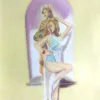
Description
According to the Associated Press (AP) headline in 1998, “Calif. Prisons To Remove Weights,” the AP wrote, “In a reversal of a trend dating to the 1960s, California prisons are moving to eliminate privileges such as access to weight-training equipment and tighten up appearance standards.
Plans are also in the works to remove law books inmates use to challenge their confinement.
“We got into the position at one juncture of providing a rather comfortable lifestyle in prison,″ said Sean Walsh, Gov. Pete Wilson’s spokesman. “We should not allow prisoners to ride roughshod over the prisons.″
The moves come as officials issue warnings about crowding in California’s 33 prisons, and as prisoners and their advocates say a tense atmosphere behind the walls is getting worse.
In addition, the changes are attracting the approval of some legislators as Wilson renews his call for the Legislature to approve $1.4 billion in bonds to help finance four new prisons.
One month ago, officials began enforcing new grooming standards that require men’s hair to be closely cropped, a measure that prompted at least 100 inmates at Folsom Prison to stage a hunger strike on New Year’s Day. The removal of weight-lifting gear is expected soon.
“It’s all part of a comprehensive review of prison operations,″ said Tom Maddock, head of the Youth and Adult Correctional Agency. “The core reasons are safety, security and taxpayer efficiency.″
Among other steps planned this year, Maddock said prison officials plan random drug tests for inmates and will prohibit packages from being sent directly to inmates. That move is aimed at reducing drug use.
A program is also afoot to require all inmates to wear white jumpsuits, instead of blue jeans and blue work shirts, thus making it more difficult for escapees to blend in, officials say.
Prisoners’ rights advocates, inmates and relatives long have criticized the Department of Corrections for what they consider its punitive approach, but these latest changes are drawing criticism from within the system.
“We’re going to drag them out of their drums cells and shave their heads?″ asked Don Novey, president of the California Correctional Peace Officers Association, the guards union. “The irony of it. You’re massively overcrowded. You’re understaffed. … It’s stupid. But it resonates with the public. We get this perception that we’re tough with the pedophiles.″
Lawyers representing prisoners and other advocates are trying to block the moves, and Sen. John Vasconcellos, D-San Jose, plans to hold a hearing on the proposals.
But many other legislators support the changes, and the department has broad authority to invoke emergency powers to change its rules.
Matthew Jay, 30, serving 15 years to life at Solano State Prison for second-degree murder, is one of thousands of prisoners whose home is a bunk in a prison gym. Lifting weights is one of the few pastimes that relieves frustration, he said; without them tensions will rise.
But he’s more worried about the potential loss of law books.
“If that access is taken away, we are no longer in a prison. We are in a war camp, like a prisoner of war,″ Jay said. “When rights are violated, we’re left with no alternative but to react. We want to prevent that.″
The trend toward greater prisoners’ rights began in the 1960s, when inmates gained expanded privileges and prison officials placed more emphasis on rehabilitation.
Gov. Ronald Reagan signed the single-paragraph Inmates Bill of Rights into law in 1968 and Gov. Edmund G. “Jerry″ Brown Jr. expanded it in 1974, stating that prisoners retained all rights except those that had to be denied in order to protect prison security and public safety.
By the 1990s, however, lawmakers took a different approach. The Legislature passed new sentencing laws and watered down the Inmates Bill of Rights. The statute now limits inmates’ rights generally to those required by the more restrictive federal laws.
California prisons had been under a 1972 federal court order to maintain full law libraries. Citing a 1996 U.S. Supreme Court decision allowing prisons to limit law libraries, the state Department of Corrections persuaded U.S. District Judge Susan Illston in San Francisco to lift the 1972 injunction, opening the way for the department to remove most law books.”
According to the California Legislative Analyst’s Office, “As of January 31, 2000 state prisons were at about 195 percent of their design capacity.” This severe overcrowding would lead to a 2011 decision by a conservative US Supreme Court to order California to release 30,000 prisoners, because of its extreme overcrowding had horrible consequences, including deaths, in violation of the 8th Amendment to the US Constitution’s Cruel and Unusual Punishment Clause. See Brown v. Platt.
It was during this era of California prisoner #K94063, Donald “C-Note” Hooker’s young Three Strikes sentence in 1998, that on January 1, 2000, he and other African Americans found themselves in solitary confinement after a riot with prison guards, at a prison the AP would later report on in a 2015 headline “Report: Alarming abuses seen at remote California prison,” and the Washington Times headlined, “State report finds ‘culture of racism,’ alarming abuses at remote Northern California prison.”
These reports were based on a California Inspector General finding. It was at this time, C-Note decided to take up picture drawing, as opposed to continuing on as a poet and writer of Rap lyrics.
Included in this era from 1998, during the whole of the 2000s saw the banning of prisoners being allowed to take photos at yard time. The new rules permitted only prisoners who received a visit could take photos, breaking with a long tradition of allowing prisoners to take photos of themselves and with others.
Since most prisoners did not receive visits, especially at a remote prison as C-Note was from 1998 – 2011, High Desert State Prison (HDSP), he had to draw a self portrait of himself, so that the people he was newly meeting through correspondence had an idea, what he looked like.



